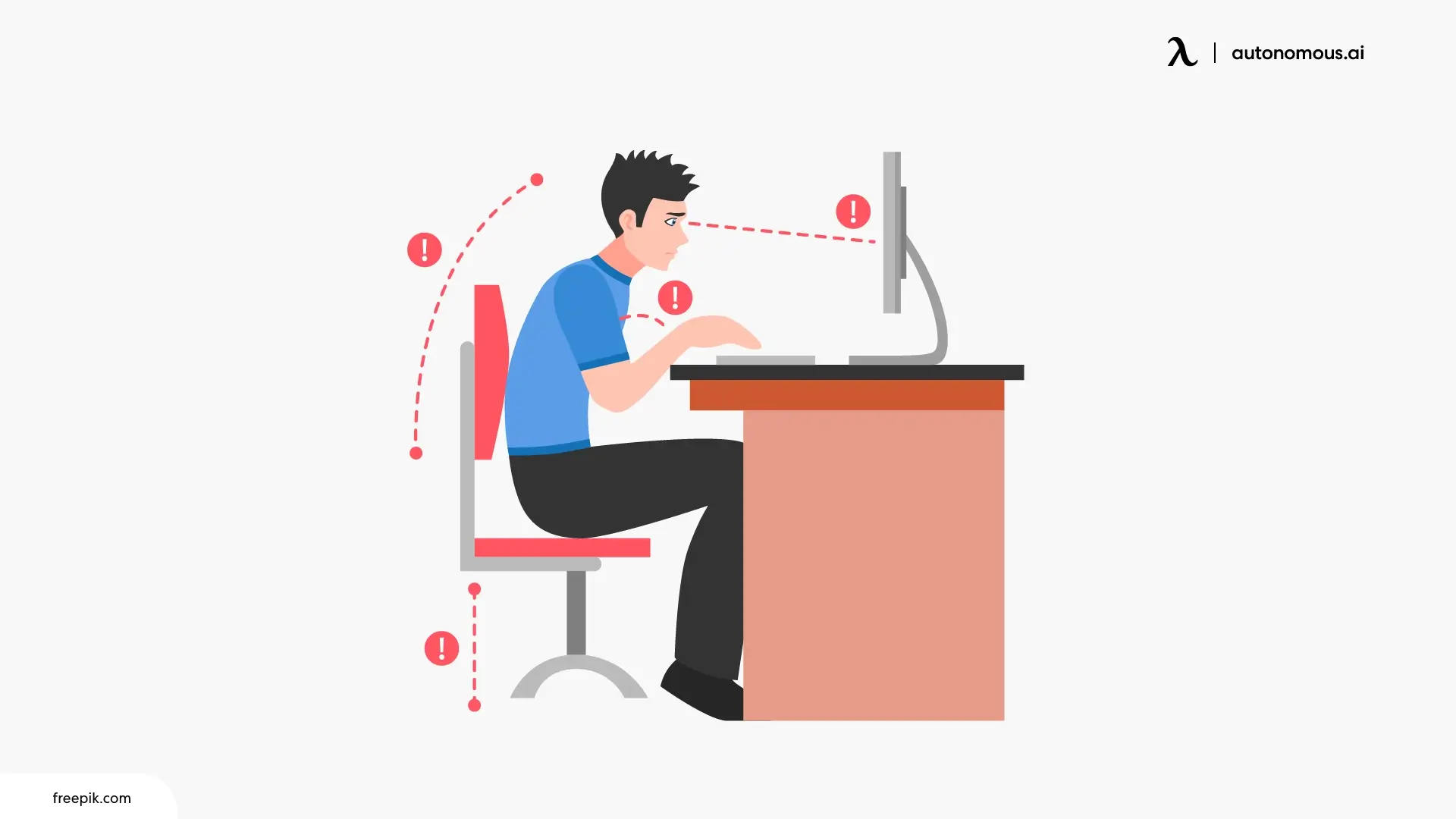
How to Stop Slouching in a Chair for Better Posture
Table of Contents
Slouching in a chair is something most of us don’t even notice until our backs start to ache. Whether you’re deep in a project, stuck in long meetings, or just glued to your screen, posture tends to take the backseat. Over time, though, this simple habit can have real consequences — from lower back pain to reduced energy throughout the day.
Many people wonder, “Is slouching in a chair bad?” The short answer: yes. Slouching back in a chair puts unnecessary pressure on your spine, weakens your core muscles, and affects everything from your breathing to your focus. The good news is, this is fixable. Learning how to stop slouching in a chair and build better posture doesn’t require a complete lifestyle overhaul — just awareness, the right setup, and a few simple habits.
This guide will break down why slouching happens, why it’s harmful, and how to prevent slouching in an office chair for good.
What Is Slouching in a Chair?
Slouching in a chair isn’t just “sitting comfortably” — it’s a posture pattern where your spine is misaligned, typically with rounded shoulders, a forward head, and a curved lower back. Over time, this position becomes so natural that you may not even realize you’re doing it until the pain sets in.
Most people slouch in office chairs because it feels effortless. You lean back, your shoulders roll forward, and your weight shifts unevenly. This posture reduces the engagement of your core and back muscles, which are essential for supporting your spine.
Another subtle sign of slouching back in a chair is when your hips slide forward while your upper back collapses into the backrest. It may not feel uncomfortable at first, but this position creates continuous pressure on your lower spine and neck.
Understanding this posture is the first step in learning how to fix posture in a chair and avoid long-term strain. In the next sections, we’ll break down why slouching happens, why it’s bad, and how to stop slouching in an office chair through ergonomic adjustments and daily habits.
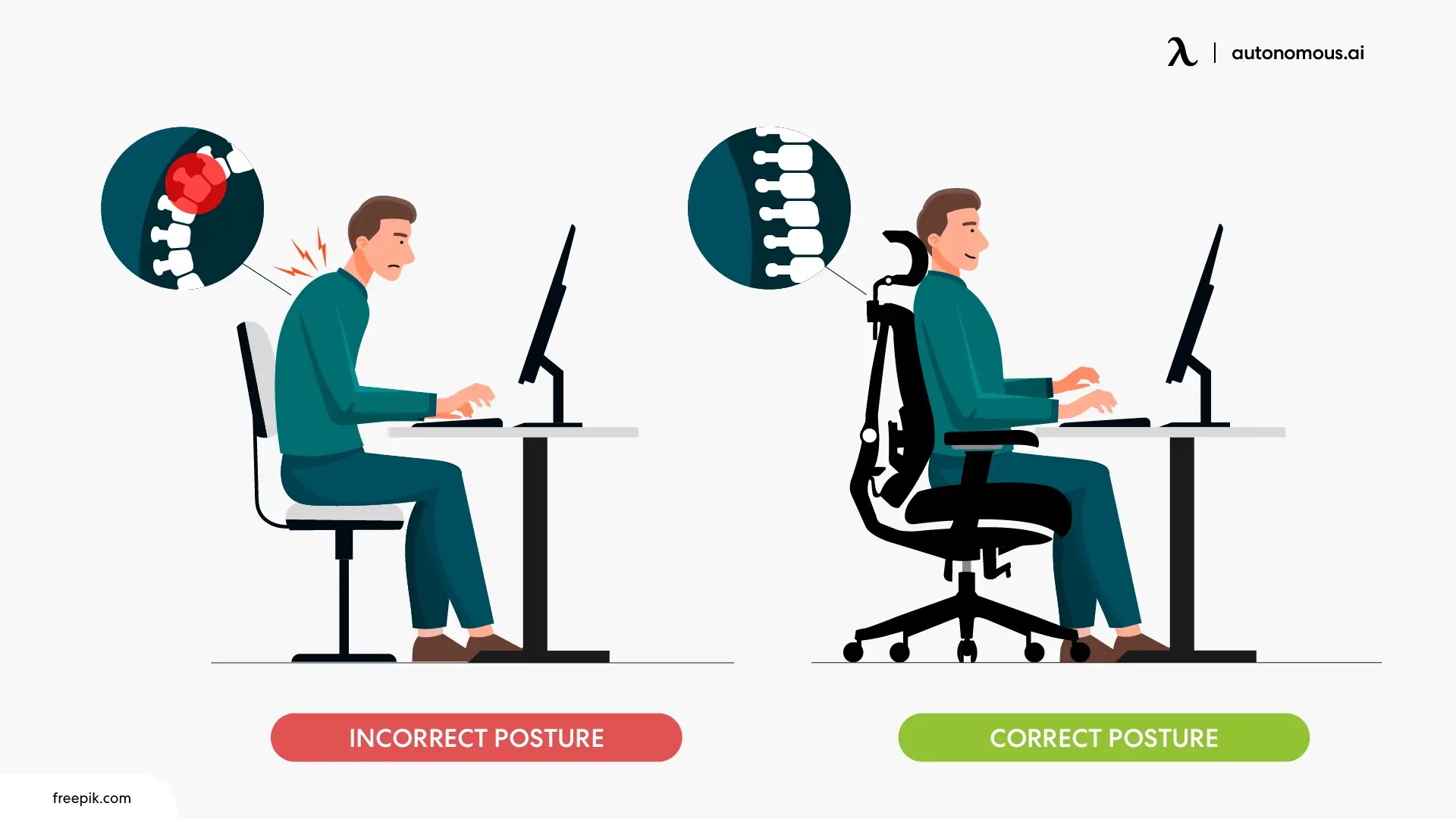
Common Causes of Slouching
Slouching in a chair rarely happens overnight. It usually builds up from small daily habits, unnoticed posture shifts, or a poor workstation setup. Once your body adapts to this position, it becomes your default — even if it’s harmful over time. Here are some of the most common reasons people end up slouching in office chairs without realizing it:
- Poor Chair Ergonomics
One of the main culprits is sitting in a chair that doesn’t support your natural spinal curve. When there’s no proper lumbar support, your lower back tends to round forward, encouraging that familiar slouching shape. Chairs that are too soft or lack adjustability make it even harder to maintain good posture.
- Sitting for Long Hours
When you’re focused on work, it’s easy to stay seated for hours without noticing how your posture slowly collapses. Fatigue causes the muscles that keep you upright to relax, making slouching back in a chair the path of least resistance.
- Incorrect Screen and Desk Height
If your monitor sits too low or too far, you naturally lean forward or hunch your shoulders to see better. The same happens if your desk is too high, forcing your shoulders to rise and rounding your upper back.
- Weak Core and Postural Muscles
Your core muscles are your posture’s foundation. When they’re weak, your body struggles to stay upright, and slouching becomes your default sitting position. Over time, this imbalance only gets worse.
- Habitual Sitting Positions
Crossing your legs, leaning to one side, or perching on the edge of your seat may feel comfortable, but they gradually train your body into misalignment. That’s why knowing how to avoid slouching in a chair also means breaking these ingrained habits.
Health Risks of Slouching
At first, slouching may feel harmless — even comfortable. But over time, the effects build up, and the body starts to show signs of strain. Consistently slouching in a chair alters the way your spine, muscles, and joints work together, leading to both short-term discomfort and long-term health issues. Here’s why it’s more serious than it looks:
- Back and Neck Pain
Lower back pain from slouching in a chair is one of the most common complaints among office workers. A slouched posture forces the spine into unnatural curves, increasing pressure on the lumbar region and straining the muscles that support it. Neck pain often follows because your head juts forward to compensate, stressing the upper spine and shoulders.
- Muscle Imbalances and Joint Strain
Prolonged slouching weakens the core, tightens the chest, and overstretches the back muscles. This imbalance makes it harder to sit upright even when you try, locking your body into poor posture patterns. Over time, it can affect the hips, shoulders, and even how you walk.
- Restricted Breathing and Circulation
When your torso collapses forward, your lungs can’t fully expand. This limits oxygen intake, which can lead to fatigue and lower productivity throughout the day. Poor circulation may also contribute to stiffness, swelling, or tingling in the legs.
- Digestive Discomfort
A slouched position compresses the abdominal area, slowing digestion and sometimes causing bloating or discomfort. It’s a subtle but real impact of slouching in office chairs for hours.
- Long-Term Postural Problems
If left unchecked, chronic slouching can lead to more permanent structural changes, like rounded shoulders, a hunched upper back, or chronic pain. Fixing these issues later often requires targeted therapy or corrective exercise, which is why early prevention is key.
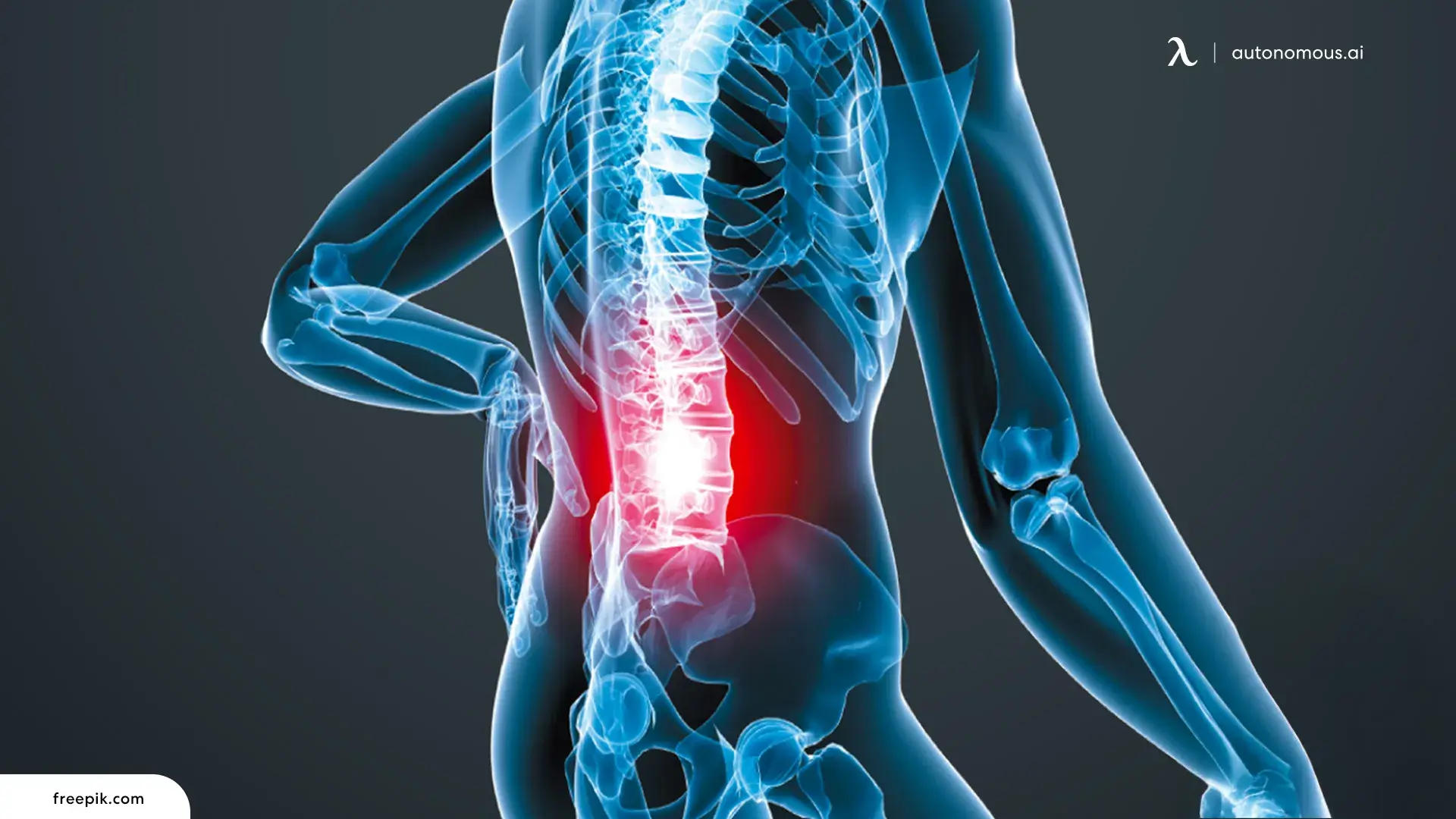
How to Fix Slouching Posture
If you’ve caught yourself slouching in your office chair more than once today, you’re not alone. Most posture problems don’t come from one bad day of sitting — they build slowly over time. The good news is, they can also be reversed with small but consistent adjustments. Here’s how to stop slouching in a chair and build better posture that actually sticks.
1. Adjust Your Chair for Proper Alignment
Your chair setup plays a massive role in posture. Start by ensuring your hips are slightly higher than your knees and your feet rest flat on the floor. This helps create a stable base and prevents your spine from rounding out of its natural curve. Ergonomic chair height plays a key role in achieving this balance.
Adjust the backrest so it fully supports the natural curve of your lower spine. If your chair has lumbar support, make sure it fits snugly into the small of your back to prevent lower back pain from slouching in a chair. A well-designed office chair with adjustable lumbar support can help maintain this alignment.
Other useful adjustments include office chairs with adjustable seat depth for better leg positioning and ergonomic chairs with adjustable armrests to ease pressure on your shoulders. More advanced options like a 4D armrest office chair or an office chair with folding arms offer flexibility to match your posture throughout the day.
For extra lower-body support, an office chair with adjustable footrest helps maintain a neutral sitting position and reduces pressure on the lower back.

2. Bring the Screen to Eye Level
One of the biggest posture killers is leaning forward to see your monitor. Keeping the display at the right height and distance encourages a neutral head and neck position, reducing shoulder rounding and upper back strain.
How far the monitor should be from your face depends on your setup, but maintaining roughly an arm’s length is ideal to avoid leaning in. Proper monitor height also helps prevent forward head posture.
An adjustable monitor arm allows you to fine-tune your screen position for optimal ergonomics. For more complex setups, a dual monitor stand or a stacked monitor setup supports multiple screens without forcing you to hunch or twist your body.

3. Keep Your Elbows at 90 Degrees
Your arms should rest comfortably on the armrests or desk with your elbows bent at around 90 degrees. Maintaining a 90-degree sitting position supports upright posture and reduces strain on your shoulders and neck.
Proper arm support also minimizes unnecessary tension. An office chair arm rest extender can help if your chair’s armrests don’t align naturally with your body. Good mouse and keyboard placement ensures your wrists and forearms stay relaxed, preventing discomfort and forearm pain from using a mouse.
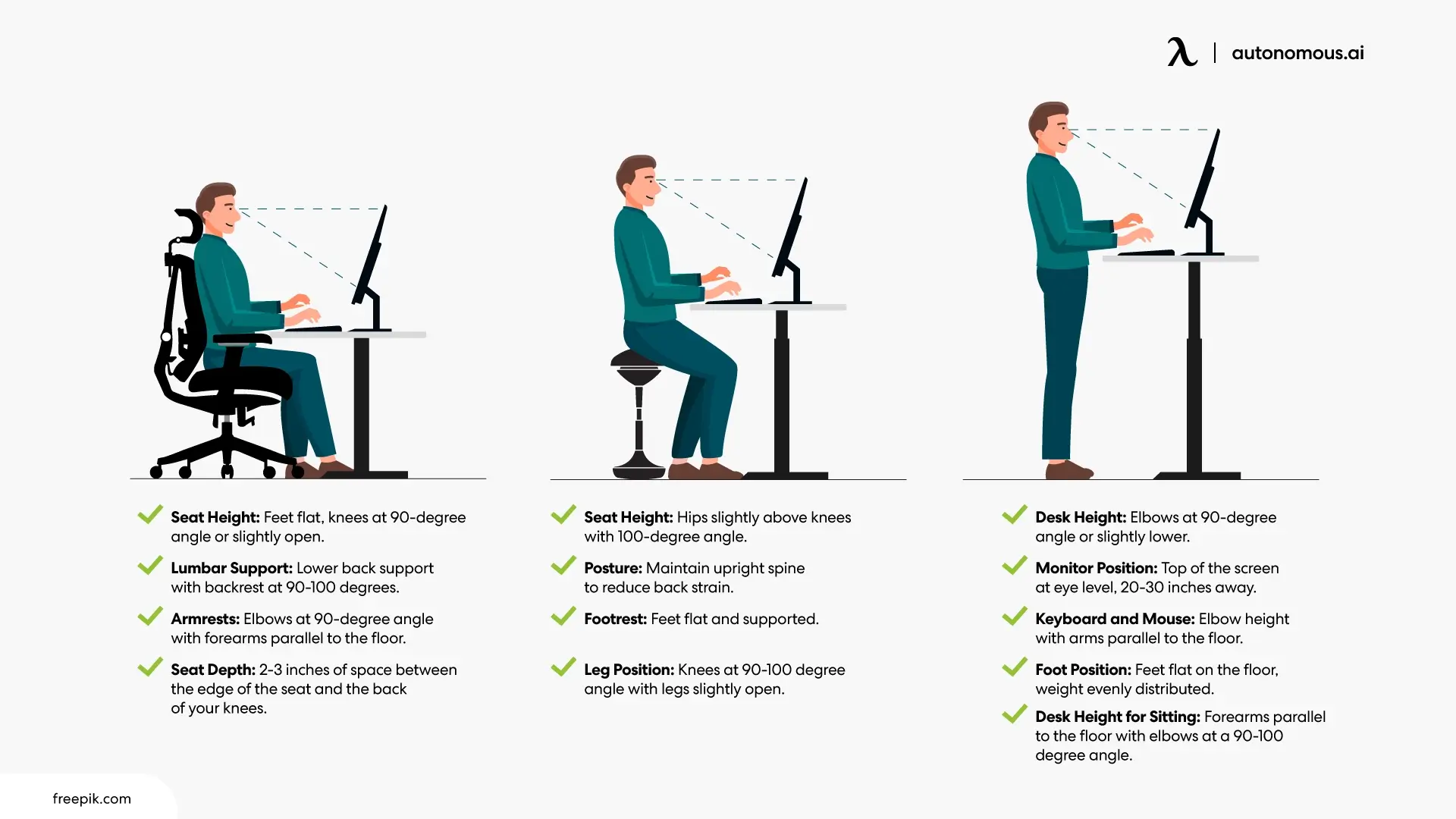
4. Strengthen Core and Postural Muscles
No ergonomic setup will fix poor posture alone. A weak core makes it harder to maintain an upright position. Incorporating light core exercises — like planks, bridges, or even seated posture drills — helps your body support itself better and reduces the tendency to slouch back in a chair.
Adding movement throughout the day can make a difference. Balance board exercises improve stability, while simple standing desk exercises activate your muscles during work. Standing back exercises are especially helpful for releasing tension and supporting better spinal alignment.
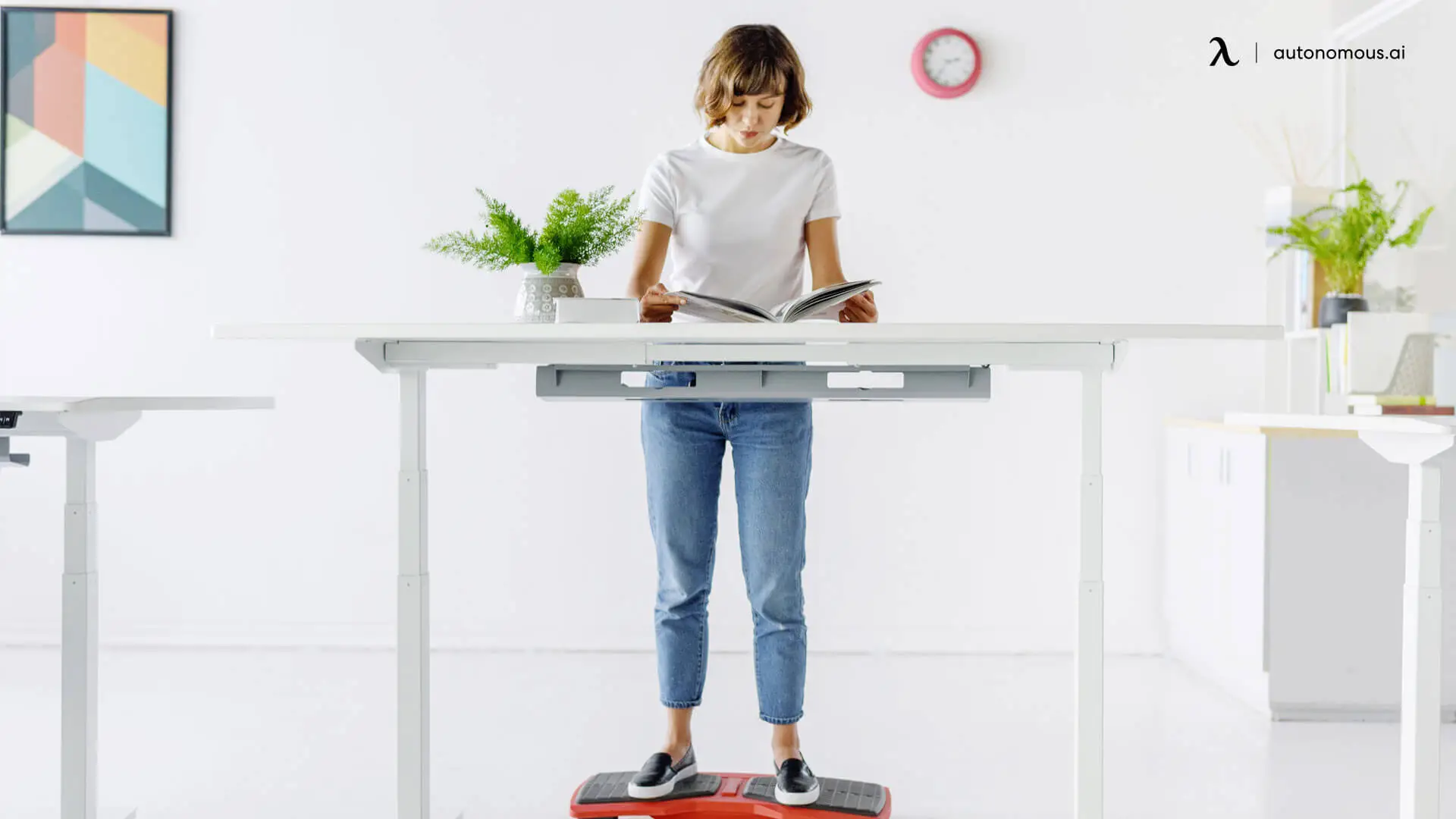
5. Use Posture Reminders and Breaks
Even with the best setup, it’s natural to relax into a slouch over time. Set gentle reminders every 30 to 60 minutes to readjust your posture. Standing up, stretching, or taking short walks helps reset your spine and improves circulation.
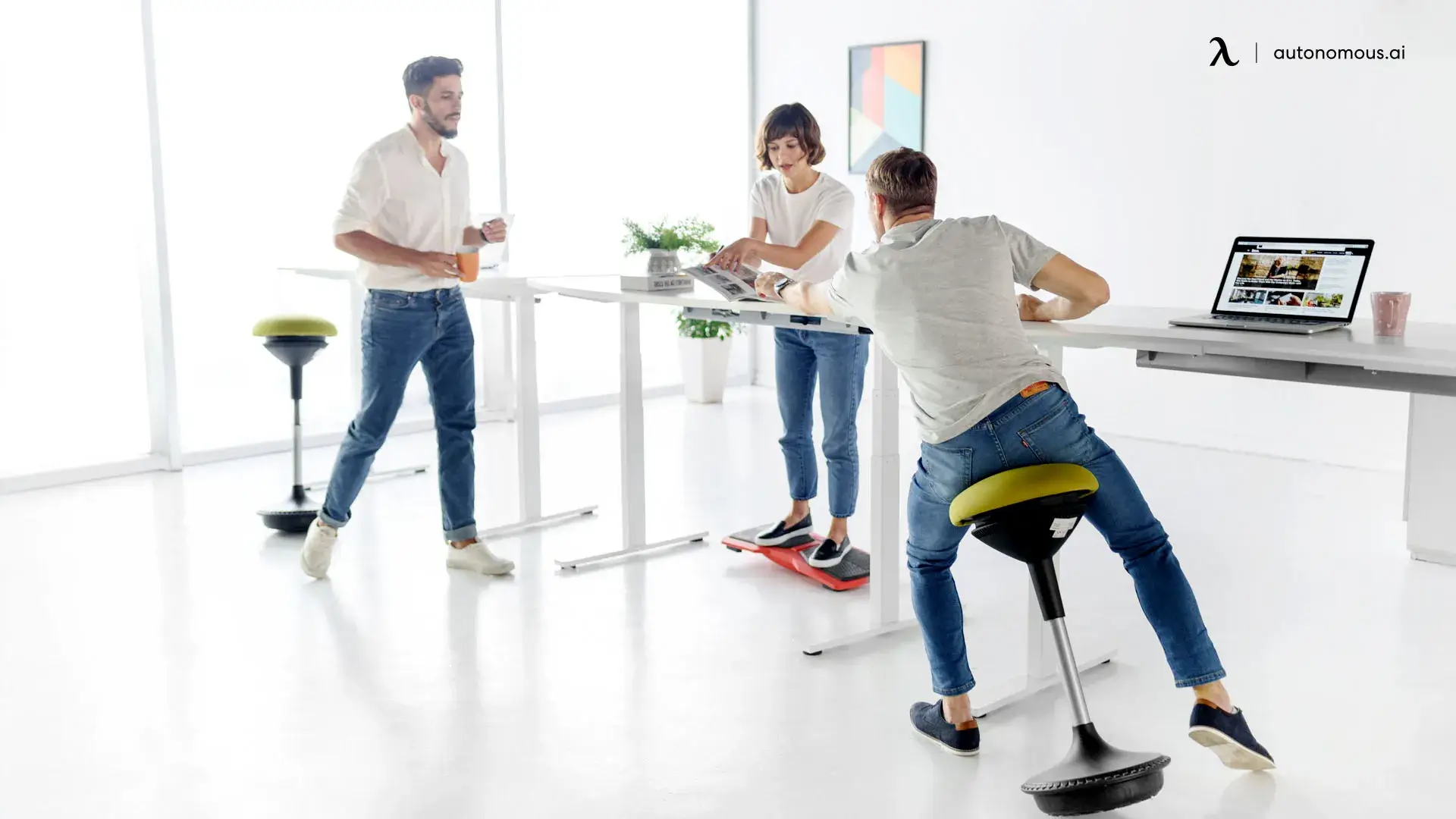
6. Train Your Body, Don’t Just Force It
Posture correction isn’t about sitting rigidly all day. It’s about creating balance by alternating between sitting and standing, moving often, and letting your spine find its natural alignment. Proper standing desk ergonomics play a big role in supporting this flexibility.
A standing desk with treadmill or active setups can make movement a natural part of the workday. Concepts like the 20-8-2 rule and active sitting help keep your muscles engaged and prevent stiffness. Even something as simple as standing for a portion of your tasks can make a noticeable difference in how your body feels and functions.
Does standing at work burn calories is often a question tied to posture — and while the calorie burn is modest, the bigger benefit comes from better movement patterns and less time spent slouched.
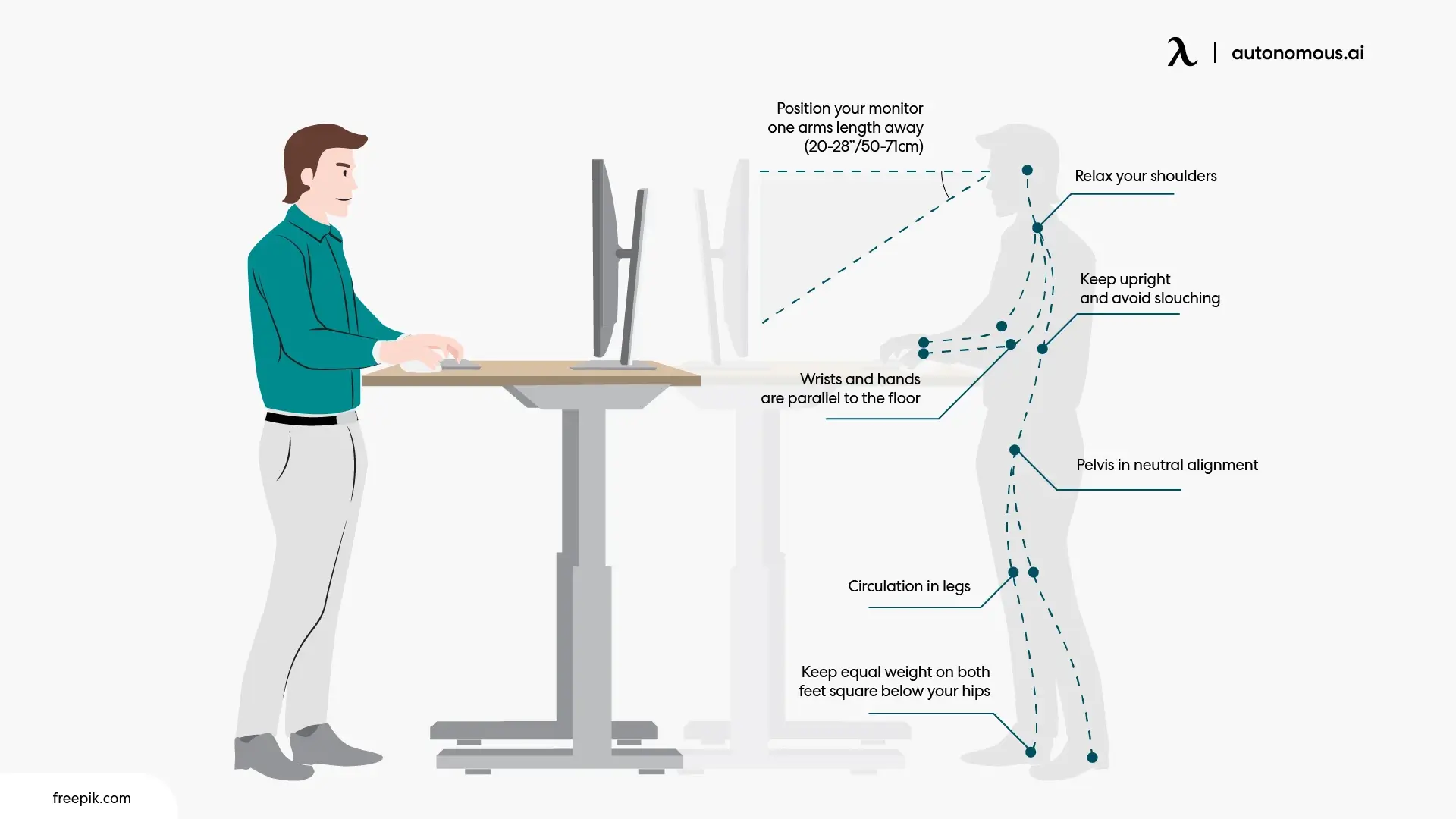
FAQs
Why is slouching in a chair bad for your body?
Slouching disrupts the spine’s natural alignment, increasing pressure on the lower back and neck. Over time, this can lead to pain, stiffness, and reduced mobility.
How does slouching in an office chair cause lower back pain?
When you slouch, your spine loses its neutral curve, putting uneven pressure on lumbar discs and weakening postural muscles. This creates strain that often shows up as persistent lower back pain.
How do I stop slouching in an office chair?
Position your monitor at eye level, keep your feet flat on the floor, and use a chair with proper lumbar support. Taking short standing breaks helps your spine reset throughout the day.
What ergonomics help prevent slouching in a chair?
An ergonomic chair with lumbar support, adjustable height, and armrests supports neutral posture. Pairing it with a properly positioned desk helps keep your spine aligned.
How can I avoid slouching in a chair when working long hours?
Alternate between sitting and standing, take micro-breaks, and engage your core to support your posture. This reduces fatigue and keeps your back from collapsing into a slouch.
Is slouching back in a chair bad even if it feels comfortable?
Yes. While leaning back might feel good temporarily, it puts uneven pressure on your spine and can cause chronic pain over time.
How to fix posture in a chair to stop slouching?
Sit with your back fully supported, hips slightly higher than your knees, and elbows at a 90-degree angle. This encourages neutral alignment and prevents rounding of the spine.
How to prevent slouching in an office chair if I already have back pain?
Use firm lumbar support, adjust your chair height to align with your desk, and break up sitting time with movement. Strengthening your core muscles also helps stabilize your spine.
How to stop slouching in a chair while seated at a desk?
Set posture reminders every 30–60 minutes. Realign your shoulders, keep your feet flat, and adjust your setup to fit your body rather than the other way around.
What happens to lung function and digestion when slouching in a chair?
Slouching compresses your chest and abdomen, limiting lung expansion and slowing digestion. Over time, this can cause fatigue, shallow breathing, and discomfort.
Conclusion
Slouching in a chair may seem like a harmless habit, but over time, it can cause real damage to your spine, muscles, and overall health. From lower back pain to reduced energy levels, the effects quietly build up through long work hours and poor sitting habits. The key isn’t just sitting up straight once in a while—it’s designing a daily routine and workspace that naturally supports good posture.
A well-adjusted ergonomic chair, a properly set desk height, and regular movement breaks can transform how your body feels after a full day of work. Whether you’re learning how to stop slouching in an office chair or trying to prevent slouching in a chair altogether, small consistent changes will lead to lasting comfort.
Good posture isn’t just about looking confident—it’s about protecting your spine, breathing better, and staying energized through the day.
.svg)

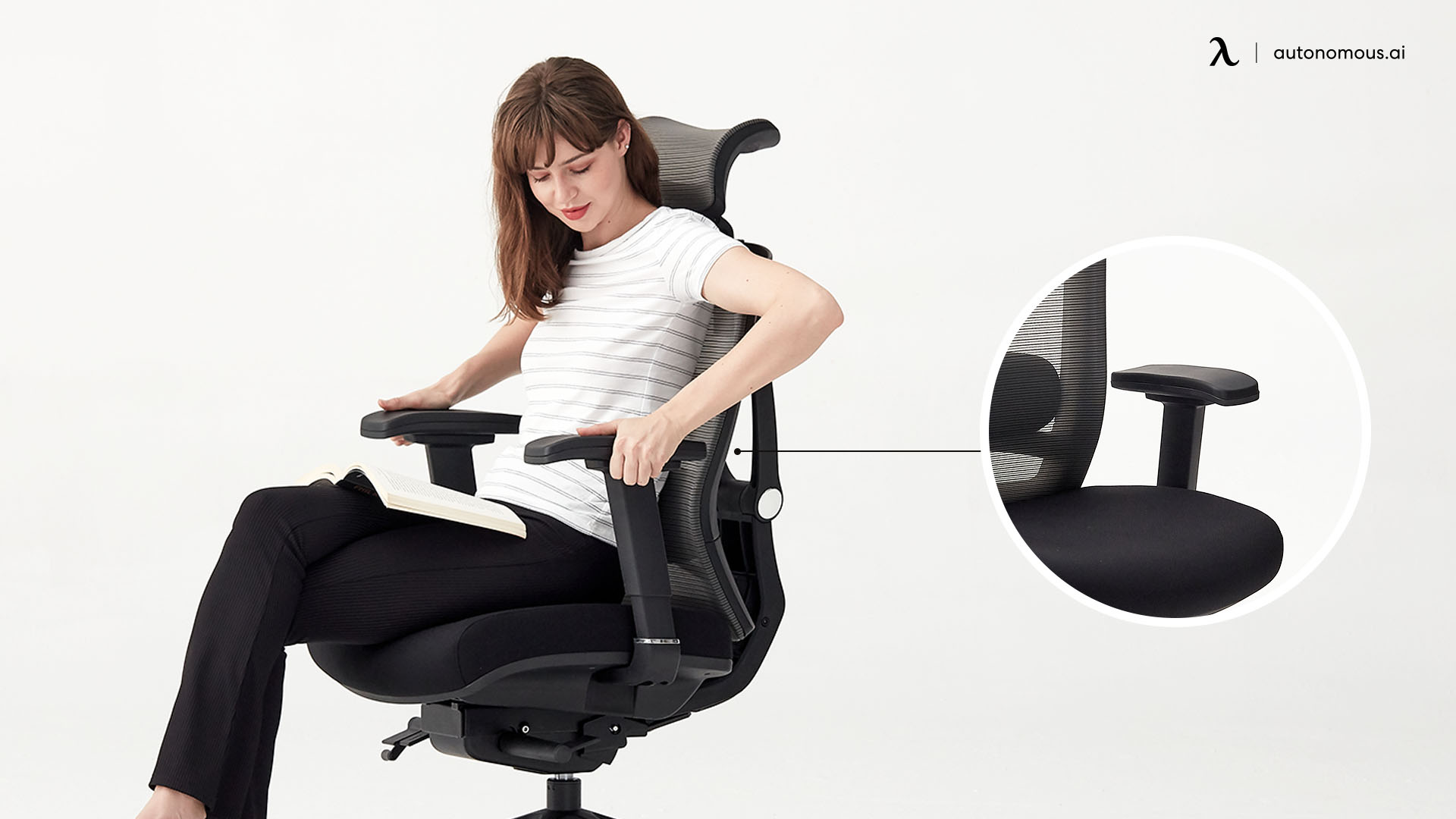

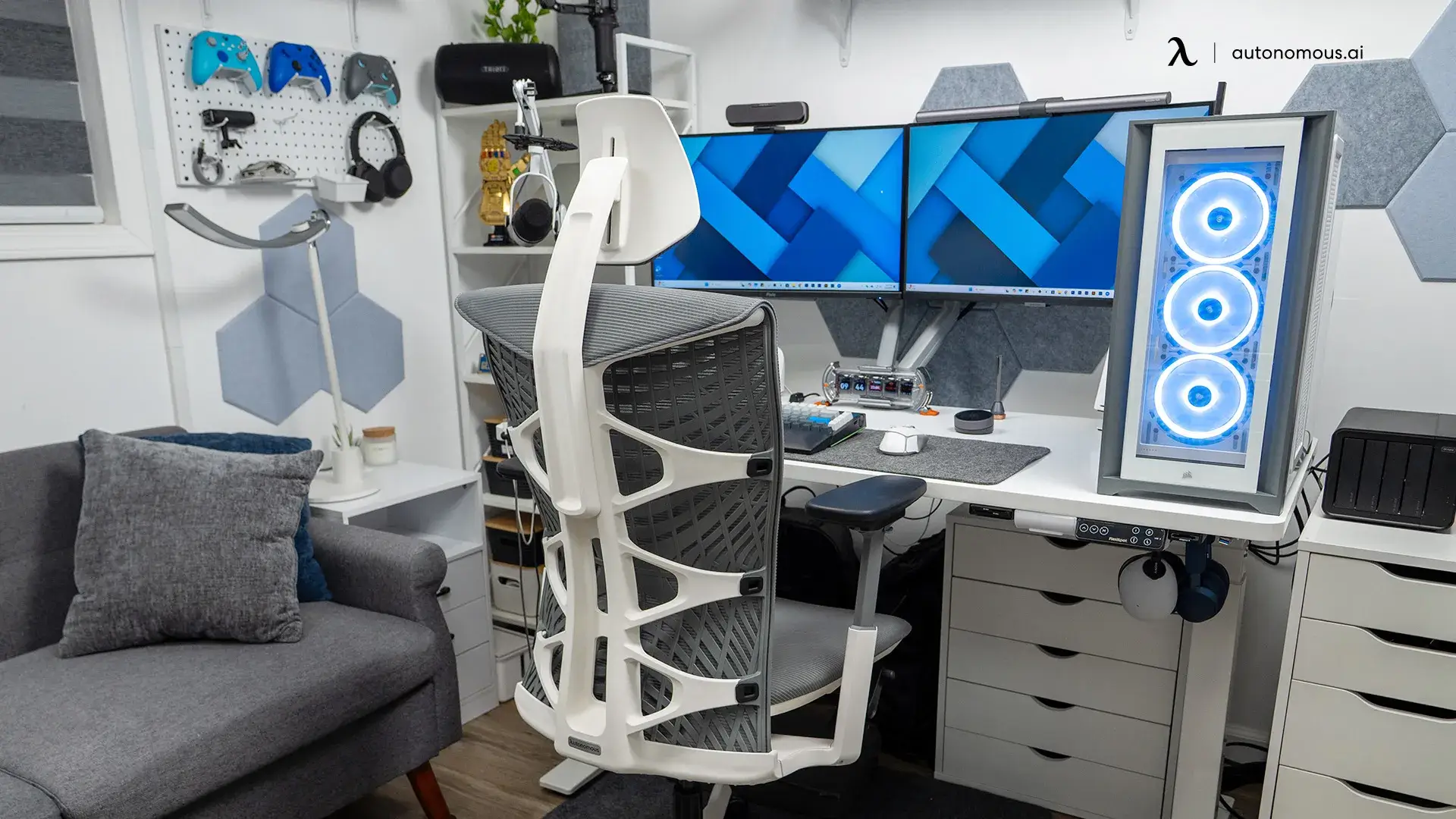


(1).webp)



